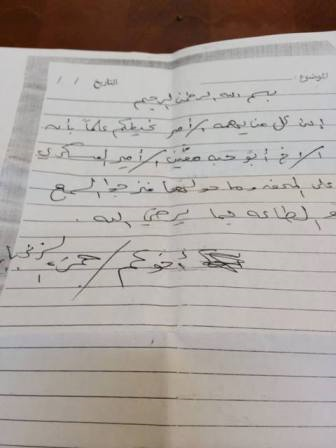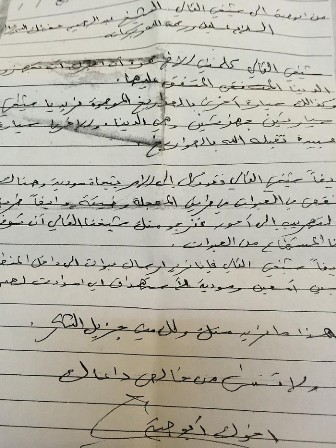Yemeni news sources are reporting that a cache of documents has been confiscated by the Yemeni military in the ongoing southern offensive against al Qaeda in the Arabian Peninsula. The documents, which were allegedly seized from al Qaeda locations in Abyan and Shabwa provinces, include communications between al Qaeda militants. Most notably, the cache includes messages between Jalal al Marqishi, also known as Hamza al Zinjibari, and other AQAP commanders.
One such document is from al Marqishi to an AQAP figure known as Abu Habbah, who is described in the messages as “the military emir of Mahfad and its environs” and what AQAP calls the “Mahfad Emirate.” Al Marqishi beseeches Abu Habbah to “listen and obey” to what pleases Allah.
In another letter, Abu Habbah asks Marqishi to prepare a shipment of missiles and explosives to be used in attacks targeting the Yemeni military as well as for the purpose of cutting off their supplies. “There is a shortage of explosives on the road to al Ma’ajalah,” Abu Habbah tells Marqishi, “and also on the smuggling route to Ahwar.”
Today’s reports regarding Jalal al Marqishi are especially relevant as information surfaces of his involvement in AQAP’s May 23 assault on the city of Seyoun in eastern Hadramout province. According to Yemeni sources, al Marqishi led the attack on Seyoun, in which reportedly up to 30 AQAP pickup trucks were used in the storming of the city.
The commander of the local Yemeni military division confirmed on May 24 that the army had regained control of the city, and military sources said that the Yemeni air force was deployed in chasing the AQAP militants out of the city. The Hadramout Security Committee said that 12 soldiers were killed and 11 were wounded in the battle for Seyoun.
The Ministry of Defense website claimed that 15 AQAP militants were killed during the course of the battle, including Saudi fighters Yarmouk, Dhibah bin Hussein al Sharwi, and Abu ‘Amir al Najdi. The same website also identified two wounded AQAP operatives: a Saudi named Anis al Sharwi and a Yemeni named Abu Khalid al Hadrami.
In related news, the governor of Abyan province, Jamal al ‘Aqel, told Yemeni news sources yesterday that the situation in his province is “stable.” He said basic services have been restored in most of the province, including Mahfad district, and that work was underway to reconnect Mahfad to the power grid. Al ‘Aqel also announced the commencement of a water project in Mahfad on June 17.
The Mahfad district in northeast Abyan province is located in a mountainous area along the border with Shabwa province. The district has been a stronghold for AQAP since 2012. The current Yemeni military offensive against AQAP began with a series of US drone strikes in late April, including one targeting AQAP training camps in Mahfad.
Al Mashhad al Yamani, a Yemeni news source, claimed that according to its figures, the Yemeni military has killed 106 AQAP militants, including 11 Saudis, since the beginning of the southern offensive in late April. Meanwhile, sources close to AQAP have said that the terrorist organization claims that only 15 of its operatives have been killed.
In related news, a statement released by Ansar al Sharia, a re-branding of AQAP, was posted today to the Facebook account of a well-known Yemeni journalist with ties to the group. The statement, titled “Statement On the Lies of the Sana’a Government Regarding The Battle of Abyan, Shabwa, and Baydha,” disputed what the government has been describing as “major victories” in the ongoing southern offensive against AQAP. “What the government has mentioned regarding major victories over the mujaheddin is nothing but a media lie and a clear fallacy,” read the statement, and claimed that Ansar al Sharia is firmly rooted throughout Yemen. It also included a theory that the government was clearing the way for the Shi’ite Houthis to penetrate the south by “striking the tribes of the Sunni people.”
Are you a dedicated reader of FDD's Long War Journal? Has our research benefitted you or your team over the years? Support our independent reporting and analysis today by considering a one-time or monthly donation. Thanks for reading! You can make a tax-deductible donation here.









